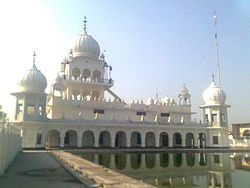|
Chhattiana, Punjab
Chhattiana is a village in the Giddarbaha tehsil of Sri Muktsar Sahib district in Punjab, India.' EconomyAs is common in the Punjab region, agriculture is the main occupation of the locals and the main source of income. The main crops of the village are, wheat and cotton. Rice growing is started few years ago in the area. As of irrigation, Monsoon greatly affects the agriculture in the region as nearly 70% of the rain falls in July–September by the Monsoon while people use canal (Jaito Rajbaha) and tube wells also. GeographyChhattiana is approximately centered at 30°19′43″N 74°40′08″E / 30.32861°N 74.66889°E. It's located in the Sri Muktsar Sahib district of Indian Punjab. The nearest city and railway station, Giddarbaha lies just 15 km in the south-west. The city and district of Bathinda lies to its south-west (32 km) and Sri Muktsar Sahib city to its north-west (22 km). Buttar Sarinh (3 km), Bhalaiana (4 km) and Rukhala (4 km) are the surrounding villages. Chhattiana is (6 km) from Doda, (30 km) from Bathinda, (27 km) from Jaito and (25 km) from Malout. Chhattiana known as "Greater Chhattiana" in area. HistoryThe tenth Sikh Guru, Guru Gobind Singh Sahib came to this place after the Battle of Muktsar (then Khidrane Dee Dhāb, now Sri Muktsar Sahib) in 1705. His soldiers asked Him for their salary as they were not paid for some time. In the meantime, one Sikh presented before the Guru with the Daswandh (1/10th or 10% of one's income) that was the gold coins. The tenth Master started distributing these coins in His soldiers as salary. The soldiers were very happy but one of the Sikh-soldiers, Bhai Daan Singh, refused to take anything.[2] When the Guru asked him that what he wants then, he replied that he wants the Sikhi, the baptism. The Guru pleased with the answer and remarked, "You have saved the honour of the faith for Malwa as Bhai Mahan Singh saved it for Majha". And then Bhai Daan Singh received the rites of the Khalsa.[3][4]
DemographicsIn 2001, as of census, the village had the total population of 3,556 with 619 households, 1,870 males and 1,686 females.[9] Thus males constitutes 53% and females 47% of the population with the sex ratio of 901 females per thousand males. References
|
||||||||||||||||||||||||||||||||||||||||||||||||||


